What can affect gray rot and how to deal with it?
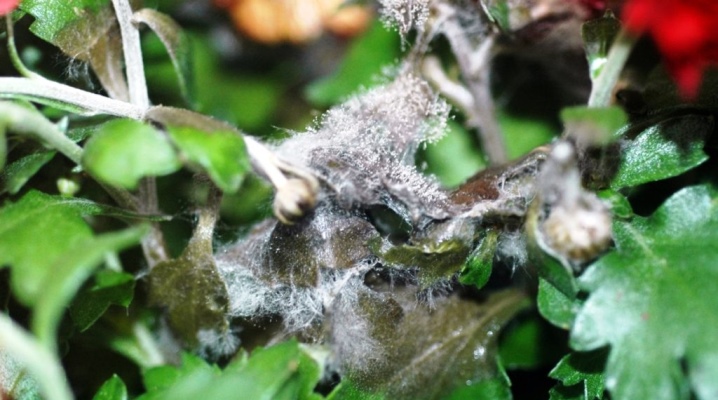
Botrytis is a beautiful word, even poetic. But, alas, this is not the name of the ancient city and not even a variety of wine, but a fungus that can destroy both wild and cultivated plants. In common people - gray rot, the enemy of strawberries, gooseberries, black currants and many other plants. Moreover, mold appears more often during storage of the crop or transportation.
What it is?
Gray rot (Botrytis cineria) is caused by the fungus Botrytis, a wound parasite. Sclerotia and conidia found in crop residues in the ground are named as the source of the disease. Usually, this disease manifests itself indoors, when drip moisture appears on the dead parts of the plant. First, the disease attacks shoots, then flowers, foliage and fruits of significantly weakened bushes.
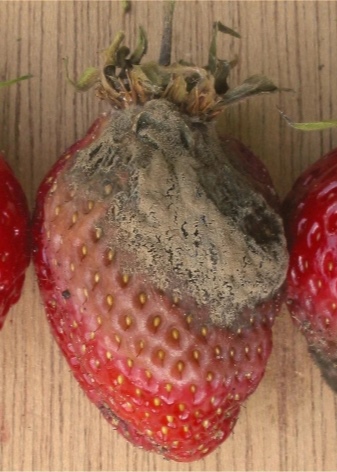

By the way, this unpleasant fungus, mold, belongs to the Higher mushrooms, that is, it is in the same category with boletus or mushrooms. But gray rot does not have the same benefits for humans as the above-named mushrooms. And it is also dangerous because for a long time it hides its aggressiveness, and the gardener is inactive. Mold looks unattractive, and also feeds on anything. This behavior of the saprophyte explains its "love" for sawdust, raw cotton fabric, and various organic residues.
If the fungus settles in a residential building, you will not immediately notice it either. But as soon as it gets colder and more humid there, it is declared the main threat to home flowers. He also penetrates the kitchen, "managing" the lockers and destroying supplies. That is, he lives not only in the greenhouse, on the site as a whole, it is a serious enemy to the entire human economy.
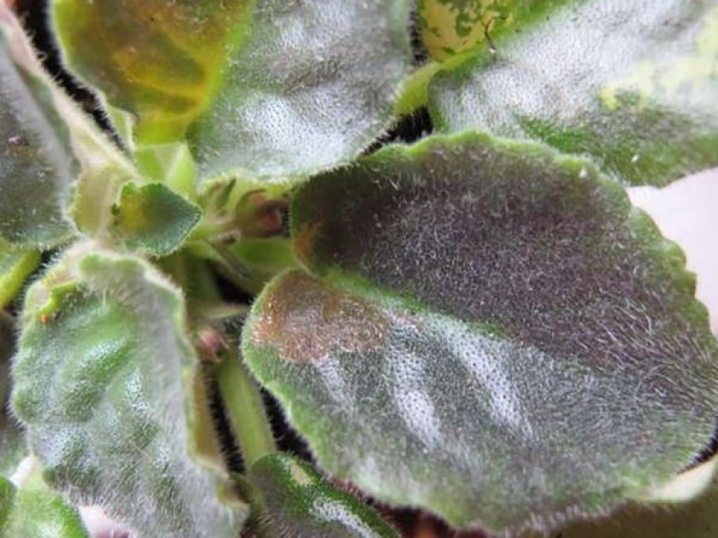
Interestingly, at the first stage, the plant is not hopeless after a botrytis attack. He, the fungus, finds a vulnerable spot in the culture, and attaches to it with a mucous substance. This does not interfere with the plant at all and does not give it a signal that it is time to bring a regiment of phytoncides into battle. While the mycelium is only gaining strength, the fungus feeds on dead plant tissues. Then comes a more aggressive stage: gray rot releases many suckers, which dig even more into the plant. And these suckers begin to actively release enzymes that suppress the plant's immunity.
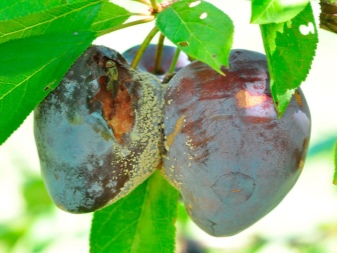
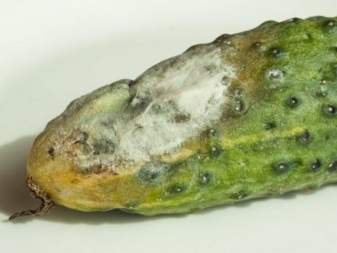
Along with this, thin long needles of the fungus dig into the affected culture, designed to penetrate deep into living cells. If there is enough sugar in the juice of the plant, the mushroom will only gain strength, because the mold feeds on sugar. A person will see this gray rot attack by the appearance of a light wet spot. But even this is not the end, the plant still has a chance to fight. Or rather, they remain with the owner, who saw rot and quickly lowered the humidity (if possible), raised the temperature, and organized the admission of fresh air. At home and in a greenhouse, it is possible to do this. And often this is enough for the insidious Botrytis to retreat.
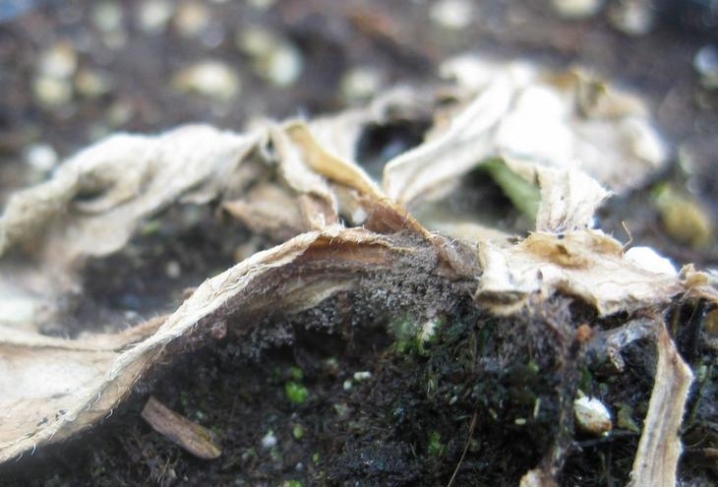
The plant itself knows how to defend itself: the question is whether it will have time to do this. When the fungus has eaten all the dead tissue, it will begin to attack the living. Hooks help him in this, mechanically destroying the walls of living plant cells. And here the culture can "gather" and bring down a lot of phytoncides on the rot, then part of the fungus may well die and fall off, and the other part will fall off along with the affected plant fragment.She, rot, is so comfortable herself - she will eat up her prey on the ground.
But not all plants do this, for various reasons it is impossible to always resist the fungus. There are weakened crops, there are species that are initially unstable to gray rot, so sometimes there is simply no chance. The prospect is darkened by the fact that Botrytis is an omnivorous fungus.
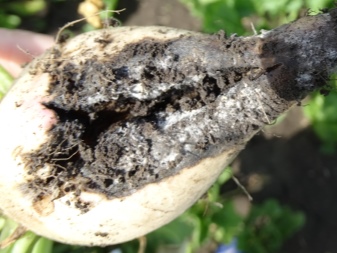
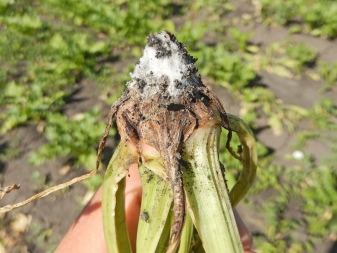
What is striking?
The causative agent of the disease is able to be on the site for a long time, eating organic matter, and the owner of the site will not even guess about it. But as soon as the humidity of the air rises and the temperature goes down, the likelihood that plants will pick up the disease becomes very high. Simply put, gray rot is waiting for the right conditions to "pounce" on sunflowers, apple trees, plums, pears, etc.
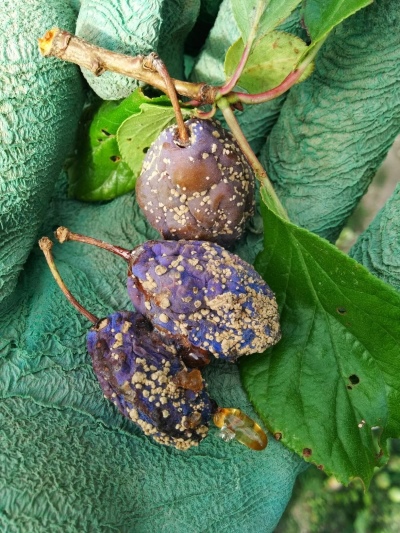
Only those berries, fruits or roots, the surface of which is already damaged, can be affected. If, for example, eggplant or strawberries are completely whole, they are not afraid of gray rot. How not afraid of her sitting in the ground, whole and healthy garlic, for example. There is even such a saying - "a parasite of a warm corpse", and it is about gray rot. At first, the fungus settles on the dead area, and already from it it moves to healthy tissue.
Flowers also cannot resist the disease: peonies, lilies, violets, petunias and phloxes are often affected by gray rot. The hydrangeas, which are fashionable today, are also afraid of her. Cabbage and grapes are also affected by Botrytis. His ailment affects root crops, he is already considered kagat rot. The crops are most vulnerable at the grafting stage, since the fungus will infect both the cuttings and the grafting area.
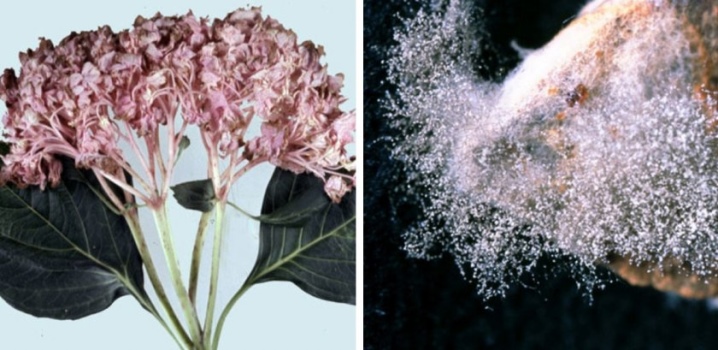
Causes of occurrence
A suitable context for the development of gray rot is waterlogged soil, poor-quality processing, high acidity. If the owners do not remove leaves and fallen fruits in time, this also increases the risk of fungus on the territory. On flowers, rot usually appears if there was a long rainy period, the temperature dropped below +15 degrees. Abundant dew also "helps" rot, and also the human factor - that is, increased watering.
And even if you untimely weed the beds, this is also the risk of fungus formation. If we are talking about street plants that inhabit tubs and flowerpots, it is possible that the formation of rot is associated with the tightness of the planting and with the fact that the soil mixture has not been renewed for a long time.


Symptoms of the disease
Almost every cultivated plant is at risk of being affected by gray mold. If it's windy outside, this risk only increases. Symptoms for different cultures are as follows.
- Tomatoes. The first sign is the detection of brown spots, they themselves dry out quickly, and the fruit begins to rot. The scary thing is that the fungus very quickly spreads to neighboring, still healthy bushes.
- Grape. The first spores of the fungus land on ripe berries, and they appear with a fluffy brownish bloom. After a couple of days, the whole bunch will dry out. The fungus will attack grapes faster in wet and hot weather.
- Strawberry. The whitish-gray bloom can be used to identify mold on the strawberries. The disease will spread just as rapidly. Morning dew, long rains and cold will aggravate the situation.
- Carrots and beets. Root crops are usually attacked by mold in storage areas. The surface of the plants is moistened, they soften noticeably, and the gray mold tries to cover the entire surface.
- Cucumbers. On the stems and leaves, grayish spots appear without a clear shape. They can also form on flowers. If no measures are taken, the fungus will transfer to the fruit, they will rot and dry out.
- Cabbage. The first sign is damage to the leaf petioles at the very base. Mold puffs up, accompanied by small black dots.
- Legumes. Rot gives itself out with a gray or olive bloom. The fungus is especially merciless to these crops.
- Currants, gooseberries. First of all, gooseberry shoots are affected by a fungus, then berries. They quickly rot and fall off.But currants are more resistant, although they are also under attack of rot - this is manifested by brown spots, gradually transforming into black mold.
- Cherry, sweet cherry. In this case, the fungus starts from the fruit. By the brown, fluffy growths, you can determine the ailment. Then the disease will spread to the branches, it will become influxes, destructive for this part of the tree. The fungus prefers overwintering in dried fruits, which is why it is so important to remove them from the site.
- Apple trees. The fungus takes hold of the fruit, which leads to their early decay. If nothing is done, the rot will spread to the wood, infect it and start drying. If you feed the trees during the growing season, the apple tree will become more resistant to gray rot.
- Flowers in the garden. Brown spots on the leaves quickly grow in size and transform into a dark bloom. Cracks-wrinkles begin to appear on the leaves, and they dry out quickly. When the fungus moves to the buds, they will die too.
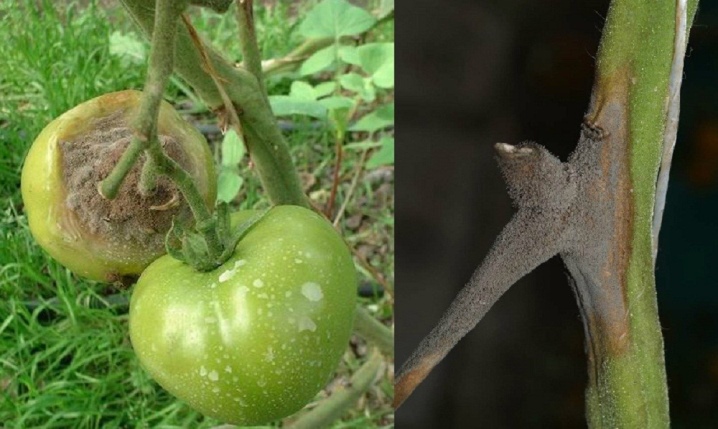
Regular inspection of plants in the garden and vegetable garden is not a self-admiration of the owner with his work, but an obligatory moment in caring for crops. Especially if the weather is conducive to fungal activity. The sooner the agrarian reveals to attack, the easier it will be to stop it.
How to treat?
You can treat plants with drugs from special stores, you can use folk methods. A you can choose a combination treatment in the name of effective control.
Drugs
You can find chemical and biological fungicides in the store. It is logical that the latter option will help get rid of gray rot with less toxicity of the process. List of effective drugs:
- for tomatoes, suitable options are "Acrobat", "Euparen" and "Fundazol", "Switch";
- garden flowers will come to life after applying the same "Fundazol", as well as "Flint", "Horus" (spraying is possible only before and after sunset);
- grapes can save Cabrio-Top or Basf AG;
- strawberries (after harvest) can be processed with "Horus" and "Strobi";
- fruit trees and berry bushes can be treated with "HOM" or Bordeaux liquid, "Fitosporin" (late autumn - after fruiting, or early spring);
- if the fungus has also penetrated the veranda, hitting indoor flowers, they will need treatment with "Teldor", "Horus EDG".
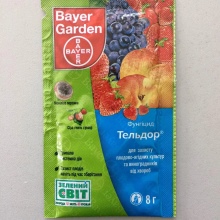
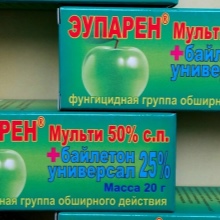
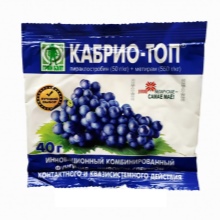
One of the most effective options is Bordeaux mixture. But you cannot use it during the ripening of the plant. And in early spring and late autumn, crops may still have nothing to fight with.
Folk remedies
There are some tricks even in planting a plant. For example, you can save strawberries from botrytis if you plant them not with bushes, but with a solid carpet. It is imperative to make paths between the beds. In the spring, strawberries are processed with Bordeaux liquid, and in the summer it is enough to remove them in a timely manner and destroy those plants that have already become infected with the fungus.
What folk remedies are considered the most effective?
- Mustard solution. 5 liters of boiling water will require 50 g of powder. This mixture is infused for two days. Before spraying the affected plants, it must be diluted with water one to one.
- Iodine. A mustard-like composition can be made from iodine - 10 drops per 10 liters of water. Insist for two days and dilute with water before use.
- Garlic. Send 100 g of garlic husks to a bucket of warm water (about 35-45 degrees), and after a day this infusion can be used.
- Copper sulfate, chalk and ash. One teaspoon of vitriol is needed, to which a glass of wood ash and a glass of chalk are added. All this is poured into a bucket of water, and the culture is treated with a solution.
- Baking soda and soap. 4 teaspoons of soda (no more, this component is very aggressive) are diluted in a bucket of water, a little shavings of laundry soap are added there. Prophylactically, the composition is used once a month and a half, and if the plants are already affected by rot, repeat the treatment twice a month until the symptoms disappear.
- Potassium permanganate. It will need 3-4 g, it is diluted in a liter of water at room temperature. It is proposed to process the plants twice a day, in the morning and in the evening, for a week.
- Copper-soap solution. Combine 0.2% copper sulfate and 2% laundry soap and take for spraying damaged plants. Repeat the treatment after 2 weeks.


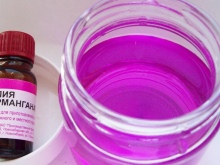
If you want to try to overcome gray rot with the most modern means, any drug with spores of the hyperparasite fungus Glyocladeum can be suitable for this role. This microorganism has an excellent appetite for botrytis.
Prevention measures
You need to take care of the harvest even before planting the plants. That's why seeds and bulbs, before they go into the ground, are treated with suitable fungicidal compositions. These are usually sulfur-based products. After the seedlings sprout, they are sprayed with Bordeaux mixture twice, organizing a break of 10 days. And the third time the plants are sprayed only after the harvest.

What else is important to prevent gray mold?
- Crop rotation is the most important part of agricultural technology, protecting plants from a variety of diseases and fungi too.
- In a timely manner, it is necessary to remove leaves, branches, berries and fruits, fallen stems and other already non-viable plant parts from the ground.
- We often have to fight pests, but these are caterpillars and moths, for example, are able to bite into fruits, and they will become vulnerable to Botrytis. Therefore, pests should not be allowed to roam.
- Before the harvest goes to storage, the place of its "wintering" must be thoroughly disinfected.
- During the growing season, crops should not experience a lack of potassium and magnesium, because they help them to strengthen their immune defenses.
- It would be nice to pre-plant plants in the garden that emit phytoncides. Calendula and nasturtium, mustard and even simple marigolds do well with this. In autumn, the site must be dug up, and plants with active release of phytoncides are buried deeper into the ground. In the spring, you can plant anything at this place.
- Novice summer residents often “sin” by actively hitting nitrogen fertilizers. This can produce abundant green mass and thicken the planting. And if the berries are shaded by dense foliage, the fruits will dry ahead of time, respectively, prematurely crack and be vulnerable to gray rot.
- Weeds need to be removed in a timely manner. Weeding is necessary so that the weeds do not interfere with the movement of air between the plants. It also prevents the fruits and inflorescences from drying out prematurely.
- In the morning, after the dew has dried on the berries, the berries must be picked. All infected are unconditionally removed and do not remain in the garden or in the garden. The berries should be picked carefully so as not to hurt or injure healthy ones. It is advisable to cool the harvested berry quickly from 0 to +10 degrees in order to prevent the disease from developing on the harvested crop.
- Mulching is also a good way to prevent gray rot by limiting the plant's contact with the soil.
If there is already rot, you urgently need to save the crop, and in order to avoid it, it is written above what to do. Fungus is not a sentence, it can be dealt with. There would be a desire and a competent approach!
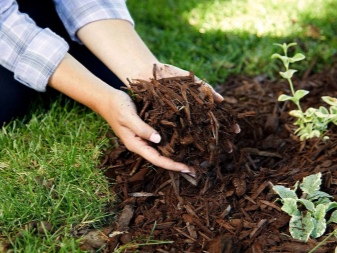














The comment was sent successfully.